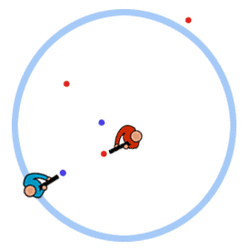Software:Strafing (gaming)
Strafing is the act of moving sideways in a video game, typically either in relation to an enemy or the game's camera. In a third-person video game the camera is positioned behind the player character, facing the direction of their forward movement, and so strafing sideways allows a player to keep the camera focused on something, such as an enemy, while moving in a different direction.
Techniques
Circle strafing
Particularly in first-person shooters (FPSs), circle strafing is the technique of moving around an opponent in a circle while facing them.[1] Circle strafing allows a player to fire continuously at an opponent while dodging counterattacks. By rapidly circling the opponent, the player evades the opponent's sights. Circle strafing is most useful in close-quarters combat, where the apparent motion of the attacking player is the greatest, and thus the chance of disorienting the opponent by making him lose track of the attacker is higher.Cite error: Closing </ref> missing for <ref> tag as it had become a standard technique used by players. The bug itself relies on mathematics: when pressing a direction key, the game adds a unit vector in that direction to the player's movement speed. The final sum, however, is never normalized - this means that by directing the avatar away from the current kinetic vector but within 90 degrees of it, the player can exceed its own top speed.[2]
Method
Strafe-jumping requires a specific combination of mouse and keyboard input. The exact technique involved depends on the game itself. In several games, there are entire maps devoted to this, much like obstacle courses.
The controls are typically as follows:
- The player presses the forward key, preparing to make the first jump.
- The player jumps, and pressing either the move left or the move right key (ergo the strafe in the term, strafe-jumping). The strafe and jump keys should be pressed at the same time, and the jump key immediately released.
- To gain maximum acceleration and speed, the player must now move the mouse gradually to the correct degree (i.e., turn) in the direction of the strafe, while still holding down the two aforementioned keys.
- For successive strafe-jumps, the player immediately jumps again on landing, swapping the direction of strafe as well as mouse turn direction if necessary to avoid obstacles.
Done correctly, this will increase the player's velocity with successive jumps. Mastering this technique requires lots of practice. Sequential strafe-jumping is mainly a matter of muscle memory, as the maximum angle of mouse motion increases slightly with consecutive jumps. Another way to increase jump speed in Quake III is a circle jump where the player gets over 500 units/sec (standard runspeed is 320 units/sec).
In some games based on the Quake 3 engine, such as Call of Duty and Wolfenstein: Enemy Territory, fractional increases in jump height can be achieved by playing the game at higher frame rates.
Circle jump
The circle jump start is the action performed by the player at the start of strafe jumping, giving a sudden burst of speed, as opposed to gaining speed with regular strafe jumping. This technique is found to have worked best in Quake engine based games.
The movements are as follows:
- The player stands about 90 degrees from the direction he intends to move in.
- The player then holds forward, the left or right strafe key (depending on which direction he intends to take), and turn to face 45 degrees the opposite way. (The player will have turned 135 degrees from his original position)
- The player now continues into strafe jumping.
Bunny hopping
Bunny hopping is a term used for different kinds of movement in games. There are two major usages of the term: In any first person shooter with jumping a player who jumps up and down to avoid being shot is sometimes called a bunny hopper. This is a very basic technique that only works against inexperienced opponents.
More advanced techniques known as bunny hopping use game physics to move faster than the base movement speed, combined with air-control (the ability to change movement direction significantly without losing speed while in the air). Techniques that gain speed without the ability to significantly change direction are often called Strafe-jumping. The physics that allow bunny hopping usually have the same calculations as those used in games that utilise Strafe Jumping with a difference that those games generally have an air speed limit of 30 units per second (which equates to approximately 15/16th of a metre or 30 inches in games utilising the Source game engine) and a high acceleration multiplication factor against the predefined maximum airspeed, ranging from 10 to very high numbers, which allow the player to surf on highly slanted slopes.
Bunny hopping exists in QuakeWorld, DeFRaG, Challenge ProMode Arena, OSP (only with cpm physics) mods for Quake III Arena, Half-Life (version 1.1.0.8, released in 2001, introduced a speed cap limiting the usefulness of bunny hopping[3][4][5]) and many of its mods and sibling games including Team Fortress Classic, Fortress Forever, Team Fortress 2, Counter-Strike, Counter-Strike, Natural Selection, Warsow, Enemy Territory Fortress (a mod for Wolfenstein), Painkiller, Kingpin, Dystopia, Counter Strike: Global Offensive, Xonotic, Fortnite, and Apex Legends.
Bunnyhopping in some games does not refer to the ability to gain horizontal speed while in a jump, such as Elder Scrolls Online, but rather gain speed through the means of jumping after landing on a sloped surface.
References
- ↑ Lancheres, Eric. Fragging Fundamentals. Fragging Fundamentals. p. 58. ISBN 0981210406. https://books.google.com/books?id=GZF0lver4MkC&dq=circle+strafing&source=gbs_navlinks_s. Retrieved 2014-11-24.
- ↑ "F3quake - Article: Strafing Theory". http://www.funender.com/quake/articles/strafing_theory.html.
- ↑ "[HL]Bring back Bunnyhopping to Half-Life! · Issue #2013 · ValveSoftware/halflife · GitHub". Github.com. https://github.com/ValveSoftware/steam-for-linux/issues/1809. Retrieved 2019-04-09.
- ↑ "Bunnyhopping - SourceRuns Wiki". https://wiki.sourceruns.org/wiki/Bunnyhopping.[better source needed]
- ↑ "Changelog before 1110 - Half-Life.Loess.ru". Hl.loess.ru. http://hl.loess.ru/?txt=changelog1110. Retrieved 2019-04-09.


